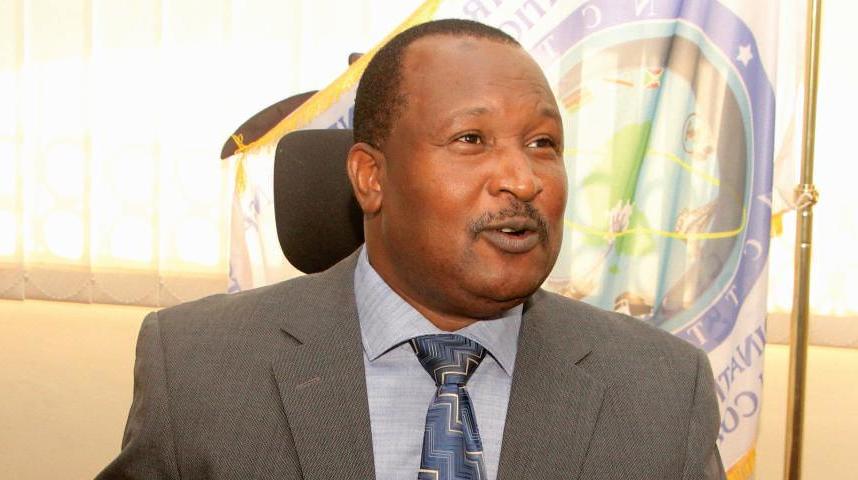
11 minute read
COVER STORY
COVER STORY
Omae Nyarandi: The Man who Believes in a Resilient Northern Corridor
Advertisement
Meet Omae Nyarandi, the Executive Secretary of Northern Corridor Transit Transport Coordination Authority (NCTTCA); an Intergovernmental Organisation incorporating six Member States that utilise the Port of Mombasa. In his endeavour to achieve this onerous task, the 51-year-old technocrat is responsible mainly for monitoring the implementation of the decisions taken by the Northern Corridor Policy Organs, ensure the overall functions and operations of the Authority, strategic planning and resource mobilisation, among others are meticulously achieved. Prior to ascending to the helm of NCTTCA, Mr Nyarandi was a director and Senior Consultant with Maritime Business and Economic Consultants - responsible for general office administration and lead consultant in Strategy, Finance and Procurement where he served between 2016 and 2018. He is a holder of an MBA in Strategic Management from the University of Nairobi, a Certified Public Accountant (CPAK), Certified Public Secretary (CPSK) as well as Chartered Institute of Purchasing & Supply (MCIPS), with over 27 years accumulated experience in areas of general management, finance and procurement. Mr. Nyarandi gained valuable experience at the Kenya Ports Authority (KPA) where he worked between 2004 and 2016 in three departments as Head of Procurement & Supplies, Head of Commercial and Head of Management Accounting; and was elevated to be the General Manager Corporate Services incharge of strategic planning, research, marketing, corporate communications and information technology (IT). Before joining KPA, he had worked for Kenya Anti-Corruption Authority, Heidelberg East Africa and Kodak Kenya Limited, serving in various capacities. He spoke to Our Managing Editor George Sunguh on a wide range of issues regarding the Northern Corridor.
COVER STORY
ASR: Northern Corridor Transit Transport Coordination Authority is now 35 years since inception in 1985, what's your main future focus?
Nyarandi: NCTTCA has made great strides in enhanced cooperation among the Member States and overall implementation of initiatives and programmes that revolutionised the Efficiency and Performance of the Corridor. Going forward, we want to focus on turning the corridor into an economic development corridor.To do this, we will involve and integrate the private sector in policy making and corridor development. The Authority has recently recruited a Kenyan to hold the post of Director, Private Sector Investment Promotion who has extensive experience trade hubs, and Private Public Partnership as well as Resource mobilization that will spearhead this initiative. The Northern Corridor policy organs took a conscious decision to bring on board the Private Sector, given that Kenya is a major stakeholder on the Northern Corridor, once Kenya takes off, it is easier for the other Member States to follow suit. The main goal is to bring in the private sector even onto the Northern Corridor Executive Committee and try to integrate the programmes of the Northern Corridor.We want to see how the private sector can invest in the Northern Corridor initiatives and projects such as hard and soft Infrastructure along the Corridor in terms of inspiring development.
ASR: NCTTCA recently undertook a survey of the Road Side Rest Stations (RSS) along the Corridor, what were the findings?
Nyarandi: We have been running the Road Side Rest Stations programme for the past five years and we have established structures in the member countries but so far, no RSS been established. RSS are important as they present an opportunity for investment in Trade and Transport Logistics aimed at improving Road safety as well as supporting cost effectiveness and reliability in the conveyance of freight and people along the Northern Corridor. The initiative of establishing RSS along the Corridor had attracted the attention of both policy makers and private sector players. It is for this reason that we have now decided to take a different route to fast track this important initiative.We thus undertook a survey to identify the infrastructure along the Corridor in the Kenyan Transit Road section that can be improved to meet the standards of an RSS. Based on characteristics of a standard Road Side Rest Station there are some Rest Sand Parking facilities that can be upgraded to the RSS level. This requires an input from the private sector to turn these areas into a fullfledged rest stations by having parking grounds for the trucks, sleeping quarters for the crew.We have had meetings with them and they are excited about it.
ASR: Sometimes back Member States decided to fund the Secretariat activities through levying cargo passing through the Port of Mombasa. How has this progressed over the years?

COVER STORY
Nyarandi: Up to 85 per cent of cargo that comes through the Port of Mombasa is imports and only 15 per cent are exports. Kenyan cargo accounts for almost 70 per cent while the other countries in the hinterland take the remaining 30 per cent with Uganda taking the lion's share. So far, all the countries except Kenya use the levy mechanism. Kenya being the main contributor, her non participation and financing her portion from Treasury has hampered the activities of the institution. The funding mechanism was deliberated by both the Executive Committee and Council of Ministers during the July 2020 meeting. Kenya's position is any additional levy to the shippers will make the corridor more costly while the other Member States opinion is that with more resources to the Secretariat, more programs to make the Corridor more competitive will be undertaken. The Policy Organs decided that a Consultant be brought on board to look at internationally accepted funding mechanism. We have invited international consultants to bid for a study to establish the most suitable modality. Currently the Secretariat budget is a round US$ 4 million.When our counterparts the Central Corridor Transit Transport Facilitation Agency (CCTTFA) went the levy way, their budget went up by US$ 3 million and are able to fund more activities. By saying our current budget is about US$ 4 million does not mean that is where we should be, but is what the Members States can afford at the moment. With this budget, we are only able to carry few priority programs.The best way is to have a sustainable uniform levy system for all Member States.
ASR:The original Uganda Railways considerably opened the hinterland, what impact do you think the Standard Gauge Railway (SGR) will have in the region in say 100 years to come?
Nyarandi: Let us take just the next 10 years. Naivasha where the railway now terminates was literally in the wilderness.The area is now growing at a full speed. Once SGR extends to Kisumu, it would mean that cargo going to Uganda will not stop at Naivasha but will proceed to Kisumu and proceed either via Lake Victoria or via the road. Kenya government's long-term plan is that Naivasha becomes a growth hub where Special Economic Zones can be developed to support the area. Instead of expecting cargo only from Mombasa we should have cargo originating from Naivasha towards Mombasa as an industrial area.There will be similar growth hubs in Kisumu, Malaba and the satellite towns along the corridor created by SGR.
ASR: Currently Port users are experiencing considerable delays at the border points especially due to the COVID 19 pandemic; how do you intend to solve this?
Nyarandi: In the initial days of the pandemic, every Member State initiated their own measures at the boarders though all had classified cargo movement as an essential service.This created congestion.We are glad that through our efforts and other state agencies, there is now uniformity in all members with the exception of Burundi which is still lagging behind.We know the main stakeholders in each Member State and it is easier to coordinate our activities. We have been conducting virtual meetings with our stakeholders and cargo intervenors all the member states together with relevant associations and agree on the information to be disseminated to the drivers.
ASR: Unprecedented long winding traffic has been observed during the COVID 19 pandemic period. Some quarters think this can be solved with a better rail network – do you agree?
Nyarandi: Yes.With a train you are talking of one entry on a scheduled flight with quite a minimal number of crew. It will definitely be a smooth flow taking just about 20 minutes at the border.
ASR: Do you prefer trains to trucks then?
Nyarandi: Certainly.Trains might not replace the trucks fully. Even in the developed countries the use of trains is recommended because it provides a smooth flow of cargo especially in long distances.The trucks still take a lion's share. Over time, the two modes of transport are able to compete and coexist.
ASR: Some voices of discontent are still being heard within the export and import fraternity using the Port of Mombasa, what are the main challenges?
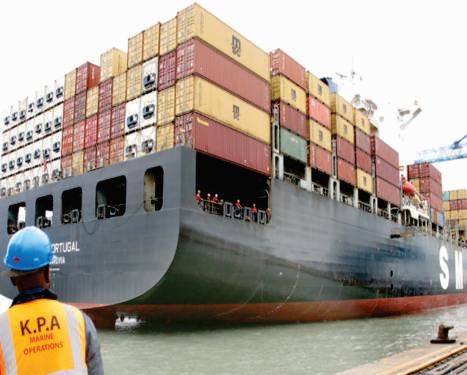

COVER STORY
Nyarandi: The biggest challenge right now is the unavailability of sufficient wagons to freight cargo from the port into the hinterland. It may appear resources, especially to Naivasha was not planned in time. Secondly some of the wagons deployed on the Mombasa and Nairobi section have gone out of service due to disrepair. The reduced wagons have resulted into over 4,000 containers lying in Mombasa waiting to be railed to Nairobi and Naivasha Inland Container Depots.The back log is almost a month and builds up at almost 400 containers a week. Kenya Ports Authority and Kenya Railways have now started ferrying containers using the closed wagons meant for the conventional cargo. This has resulted into operational delays as the cranes have to pick cargo from inside the wagons other than from the sides making it quite cumbersome. New wagons have however been ordered and will be at the port soon.
ASR:What support have you offered long distance truck drivers during the COVID 19 pandemic period?
Nyarandi: We created awareness around the stigmatization that came with COVID 19.We decided to disseminate the information to all the stakeholders that cargo transportation is an essential service. Indeed the drivers are sacrificing a lot to offer the essential service during such difficult times.We took them through how to stay safe along the corridor.We distributed 10,000 face masks 1,000 reflector jackets, installed a water tank and continuously provided water and sanitizing facilities at the Miritini COVID 19 Testing Point.Together with the County of Mombasa and KPA, we increased the capacity of COVID 19 testing from 100 to 500 persons per day.We have been interacting with them and giving them messages of hope.
ASR: To what extent did COVID19 affect Transit time along the Northern Corridor?
Nyarandi: Transit time on most of the routes along the Northern Corridor worsened partly due to the border crossing challenges and driver testing requirement for the COVID-19. In addition, COVID-19 containment measures including lockdowns, curfews, and social distancing measures slowed down processes contributing to high transit time. During the period between July and September 2020, drivers were experiencing a long stay at border points as they awaited clearance, with long queues of trucks reported at the Malaba border.The Northern Corridor Transport Observatory Data fortunately reveals an increase in number of consignments plying the Taveta/Holili route through the Northern Corridor.A total of 941 trucks armed with the Electronic Cargo Tracking System gadget were recorded for the quarter ending September 2020 on the MombasaTaveta route.
ASR: How many Tracks are on the Corridors at any given time?
Nyarandi: Before the outbreak of Coronavirus, the average daily truck traffic at Mariakani Weighbridge was around 5,000 Trucks.As an illustration, from January to September 2018, the average Truck traffic at Mariakani was 43,568 trucks from the Port of Mombasa. During the same period under COVID-19 (Jan-Sept. 2020), the average truck traffic at Mariakani was reduced to 24,854 Trucks. Some cargo trucks originate from Nairobi, Naivasha, Eldoret and other major towns, adding to the population on the Corridor. At the same time, about 450 drivers undertake the COVID 19 test at the Miritini on daily basis. Given that the certificates have a life span of 14 days you can find a bout 1,000 trucks exiting the Port of Mombasa on each day.
ASR:What measures would you share with Stakeholders to address numerous challenges affecting transport and trade logistics?
Nyarandi: In an attempt to address the numerous challenges affecting transport and trade logistics due to COVID-19 pandemic, there is a need for a detailed assessment of the Northern Corridor region vulnerability, so that national and transboundary disaster mitigation measures may be put in place. Member States therefore need to adopt a harmonized disaster response mechanism to safeguard the transport corridor; share intelligence from early-warning systems; conduct capacity-building for personnel involved in the transport logistics chain; and embed disaster responses into national and regional policies that affect trade, transport and other related infrastructure.
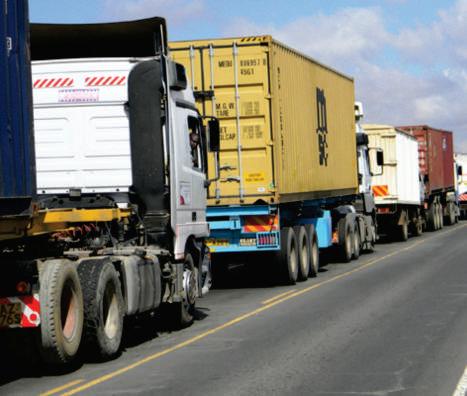
NCTTCA has made great strides in enhanced cooperation among the Member States and overall implementation of initiatives and programmes that revolutionised the Efficiency and Performance of the Corridor - Mr. Nyarandi ,,
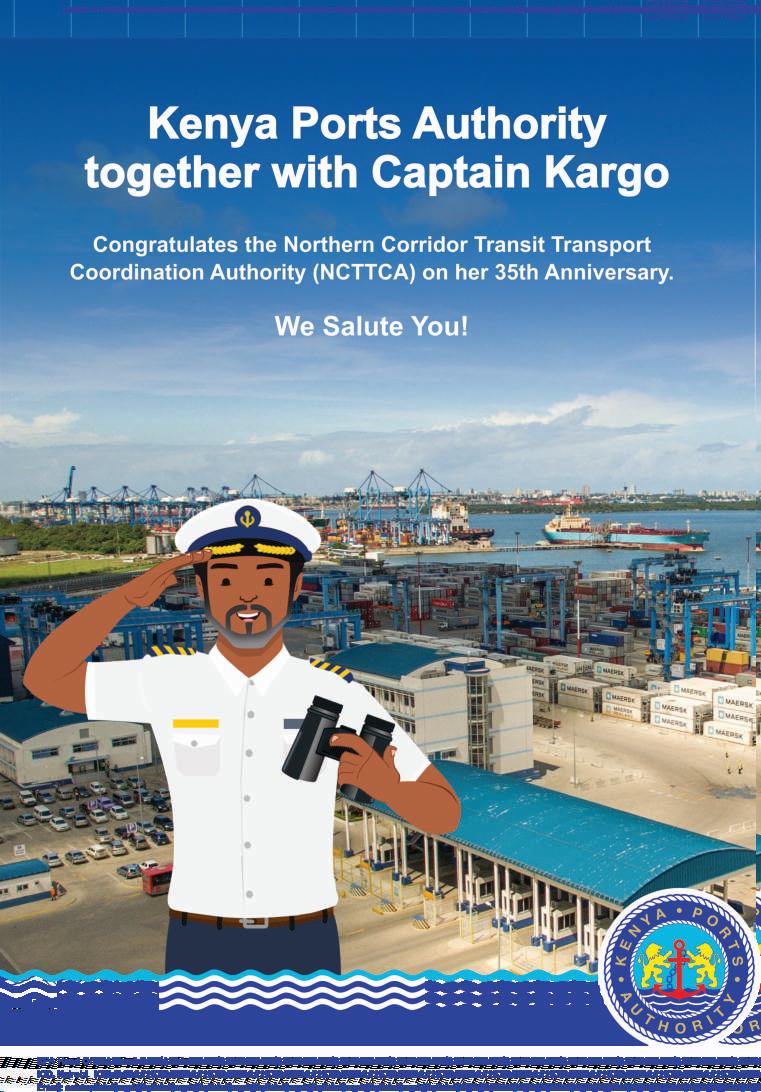
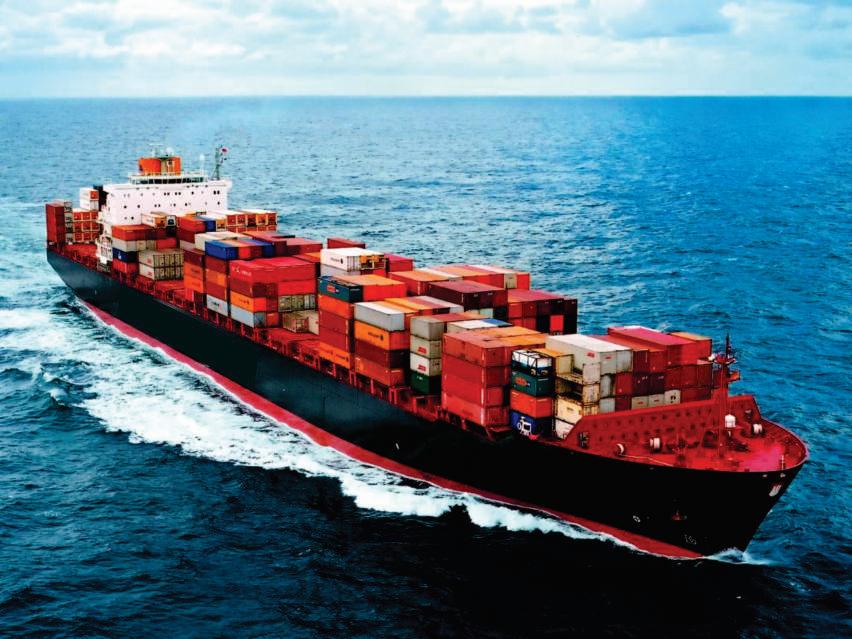
For safe and efficient water transport
Kenya Maritime Authority (KMA) is proud to be associated with the Northern Corridor Transit Transport Coordination Authority (NCTTA) as it celebrates its th35 Anniversary of a dedicated service to the transport and trade industry in the Eastern African region.
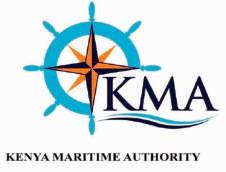
FOR MORE INFORMATION Contact us through:
THE DIRECTOR GENERAL, KENYA MARITIME AUTHORITY P.O. Box 95076 - 80104, MOMBASA Telephone: +254 41 2318398/9, +254 20 2381203/4, 0724319344, 0733221322
Fax: E-mail:+254 41 2318397 info@kma.go.ke; complaints@kma.go.ke Website: www.kma.go.ke
Follow us on: :kmakenya@kmakenya :Kenya Maritime Authority










